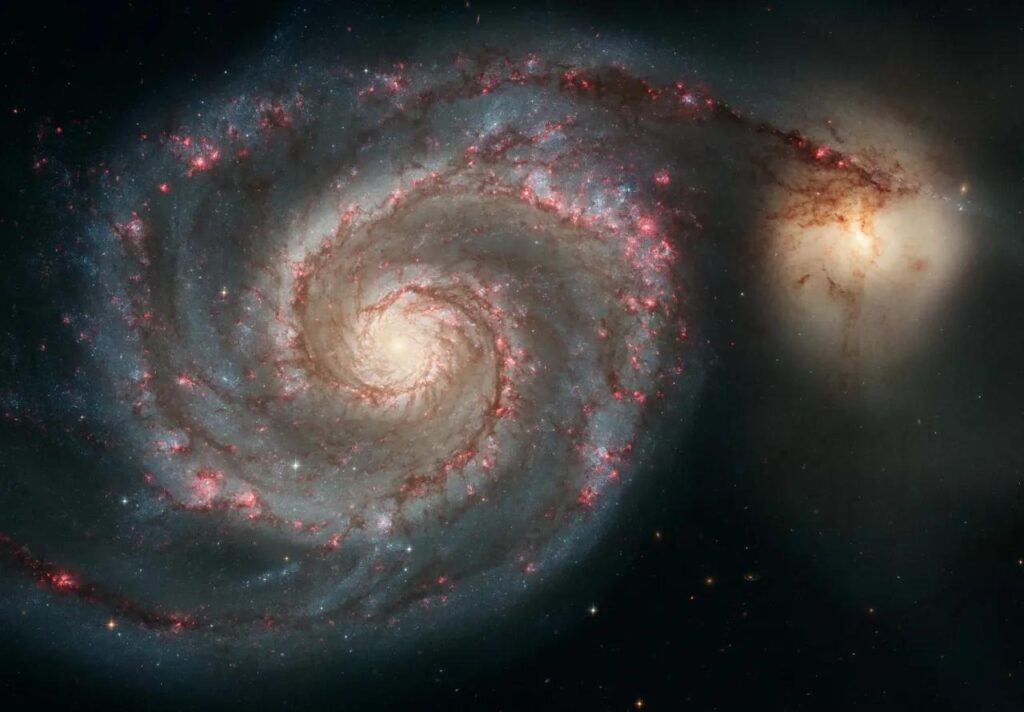M51, also known as the Whirlpool Galaxy, is one of the most famous and studied galaxies in the night sky. It is located in the constellation Canes Venatici which lies close to the Big Dipper. Here’s an overview of this beautiful galaxy:
Structure and Features
M51 is a classic example of a grand-design spiral galaxy, meaning it has well-defined spiral arms. The arms are sites of intense star formation, which is evidenced by numerous young, hot, blue stars and the presence of HII regions.
H II regions are areas of ionized hydrogen gas, where high-energy ultraviolet light from young, massive stars has stripped electrons from hydrogen atoms. These regions typically mark the sites of active star formation, as they contain dense clouds of gas and dust that serve as the raw material for new stars.
In M51, the spiral arms are particularly rich in these H II regions, which are lit up by the radiation from newly formed stars. The dense molecular clouds of hydrogen in these areas collapse under gravity, triggering the birth of new stars.
M51 has a companion, NGC 5195, which is a dwarf galaxy. The interaction with NGC 5195 is believed to be responsible for its prominent spiral structure. The gravitational forces between the two galaxies trigger waves of star formation in M51’s arms, producing tidal tails and bridges of stars and gas between the two galaxies.
The galaxy has a Seyfert 2 nucleus, indicating an active galactic nucleus (AGN). This suggests that there is a supermassive black hole at its center that is actively accreting material and emitting significant radiation.
The galaxy is roughly 60,000 light years in diameter, and about 23 million light years distant from earth.
Research and Exploration
The Hubble Space Telescope has provided some of the most detailed images of M51, allowing astronomers to study its structure, star formation regions, and the interaction with its companion in great detail.
Observations in the radio and infrared wavelengths have provided insights into the molecular gas and dust content, further enhancing the understanding of star formation processes in M51.
Ongoing studies aim to understand the detailed mechanics of the interaction with NGC 5195, the nature of its active nucleus, and the distribution of dark matter within the galaxy.

Observing the Galaxy
M51 is best observed in the Northern Hemisphere during the spring months (from March to May) when Canes Venatici is high in the night sky. It is positioned near the handle of the Big Dipper (Ursa Major), making it easier to find.
Observing from a dark sky site, away from city lights, will provide the best view of the galaxy. Moonless nights will allow for even clearer and more detailed views of faint objects like this galaxy. Light pollution can wash out its details.
Under excellent viewing conditions, M51 can be seen as a faint fuzzy patch with binoculars. A small telescope (4-6 inches in aperture) will reveal M51 and its companion, NGC 5195, as faint smudges. Larger telescopes (8 inches or more) will show more detail, including the spiral structure and the interaction between the two galaxies.
By planning your observations and following these tips, you can have a rewarding experience observing one of the most iconic galaxies in the night sky.



